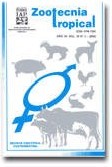
|
Zootecnia Tropical
Instituto Nacional de Investigaciones Agrícolas Venezuela
ISSN: 0798-7269
Vol. 19, No. 1, 2001, pp. 81-87
|
 Bioline Code: zt01007
Bioline Code: zt01007
Full paper language: Spanish
Document type: Research Article
Document available free of charge
|
|
|
Zootecnia Tropical, Vol. 19, No. 1, 2001, pp. 81-87
| en |
Technical Note - REPRODUCTIVE PARAMETERS OF A GOAT FLOCK UNDER TRADITIONAL MANAGEMENT IN RIO HONDO DEPARTMENT (SANTIAGO DEL ESTERO - ARGENTINA)
Alicia E. Rabasa; Jorge L. Fernández y Silvina A. Saldaño
Abstract
The objective of the present work was to describe the reproductive behavior of a goat flock under traditional extensive management. It was carried out under subtropical semiarid environmental conditions (Santiago del Estero, Argentina) in the farm of a small producer, studying the fertility and prolificacy of Criollas goats. The Criollas goat flock was conformed by 42 females and 2 males staying all together during the studying periods, January 1998 till June 1999. The elapsed time was divided in three parturition seasons: fall, winter and spring. The animals grazed at native woods during 8 hours a day, without pastor and with nightly confinement. The fertility, fecundity and prolificacy were quantified. The data analysis was performed using a non-parametric test, Chi square. The results showed births along whole year, with parturition values ranging from 40-80% and high levels of prolificacy (1.66-2.20%). These results argue with others workers which, in tropical environments, observed a lack of stationary warms and due to it, parturition along the year.
Keywords
goat, Criolla, fertility index
|
| |
| es |
NOTA TÉCNICA - Parámetros reproductivos de una majada caprina con manejo tradicional en el Dpto. Río Hondo (Santiago del Estero, Argentina)
Alicia E. Rabasa; Jorge L. Fernández y Silvina A. Saldaño
Resumen
El objetivo de este trabajo fue describir el comportamiento reproductivo de una majada con manejo tradicional y extensivo. El mismo se realizó en el predio de un pequeño productor, representativo del área, estudiando la fertilidad y la prolificidad de cabras Criollas, en un ambiente subtropical-semiárido (Santiago del Estero, Argentina). La majada estaba compuesta por 42 hembras y 2 machos que permanecieron juntos durante el estudio, que se extendió desde Enero de 1998 a Junio de 1999. Este período se dividió en tres épocas de parición: otoño, invierno y primavera. El manejo fue extensivo. La majada pastoreaba monte natural durante 8 horas diarias, sin pastor, con encierre nocturno. Se cuantificó la fertilidad (cabras paridas por cabra expuesta a servicio), la fecundidad (número de cabritos nacidos por cabra expuesta) y la prolificidad (número de cabritos nacidos por cabra parida). El análisis de los datos se realizó a través del test no paramétrico de Chi cuadrado. Los resultados mostraron nacimientos durante todo el año, con valores de parición que fluctuaron entre 40-80 %, de fecundidad (0.90 - 1.80) y de prolificidad (1.66 - 2.20 %). Estos resultados son coincidentes con los de otros autores que, en condiciones tropicales, observan una falta de estacionalidad y en consecuencia pariciones durante todo el año.
Palabras-clave
cabras, Criolla, índices de fertilidad
|
| |
© Copyright 2001 - Zootecnia Tropical. Free full-text also available online at http://www.ceniap.gov.ve/bdigital/ztzoo/zooindex.htm
Alternative site location: http://www.sian.inia.gob.ve/repositorio/revistas_ci/ZootecniaTropical/ztindice.htm
|
|
